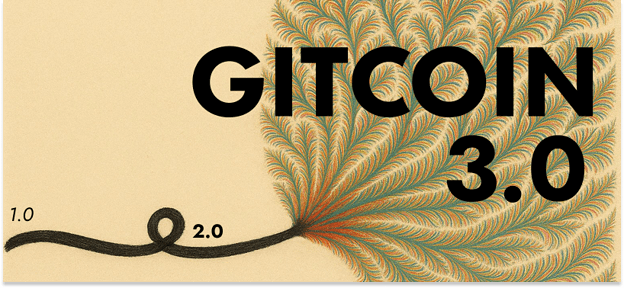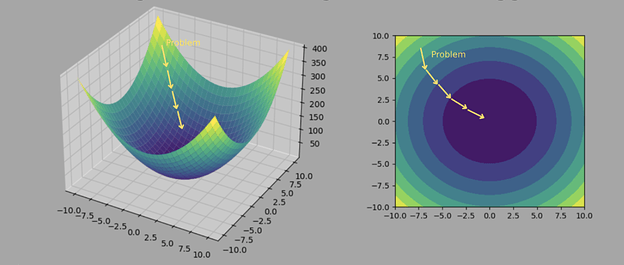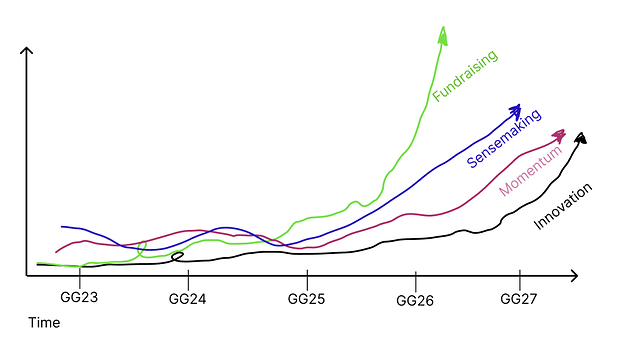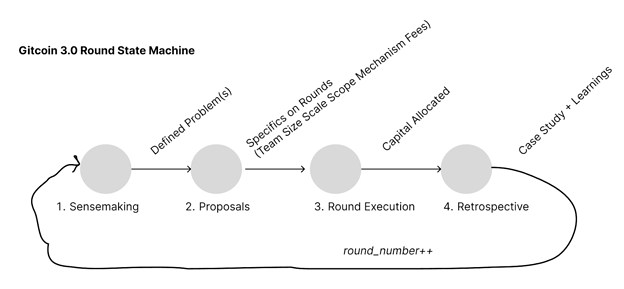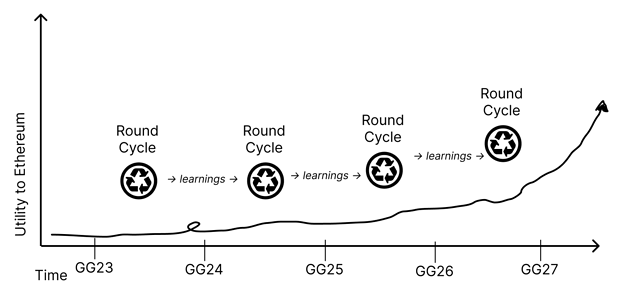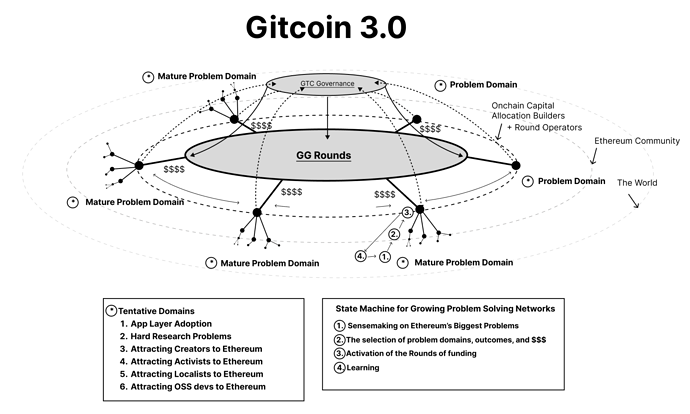IMPORTANT - This is Owocki’s vision for Gitcoin 3.0. Digest it, debate, it fork it, make changes. Nothing is official until ratified by governance!!
Gitcoin is entering a new era— what I call Gitcoin 3.0.
While the Gitcoin 1.0 era (2017-2021) was a centralized company, and the Gitcoin 2.0 era (2021-2025) attempted to turn the company to a DAO but that didnt work, Gitcoin 3.0 starts fresh with a new GG program design for 2025 - 2030.
My Vision for Gitcoin 3.0
Network-First Funding Festival for Ethereum’s Biggest Problems
TLDR
Gitcoin 3.0 features a well-funded treasury (~$22M for 5+ years runway),which we can use to power a Network-First Funding Festival for Ethereum’s Biggest Problems.
The core offering is GG (the Gitcoin Grant program), which will identify + fund people who solve Ethereum’s biggest problems. Like our Gitcoin 2.0 era GG rounds, the Gitcoin 3.0 era GG rounds occur twice or thrice yearly. But unlike the Gitcoin 2.0 era, we are not just quadratic funding anymore.
The GG program is designed to stimulate the identification + funding of Ethereum’s biggest problems. It does so by allowing network leaders to leverage onchain capital allocation mechanisms (such as QF, Retro Funding, Deep Funding, and more), and Gitcoin’s matching pool + audience, to identify + solve Ethereum’s biggest problems.
The GG program promotes competition among diverse capital allocators, creating a schelling point around which forward builder energy can be accelerated through experimentation, learning, and innovation.
You are invited to participate in Gitcoin 3.0 and help us Fund What Matters in Ethereum.
Welcome to Gitcoin 3.0
Gitcoin 3.0 is a Network-First Funding Festival for Ethereum’s Biggest Problems
Here are six key things you need to know (est read time: six minutes)
1. Treasury is Funded for Years
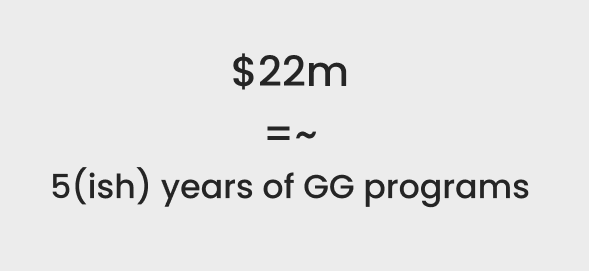
Gitcoin’s treasury is well-capitalized with about $22m worth of liquid assets, ensuring sustainability and strategic growth for the next five years.
Of the $22m, about $11m sits in the DAO treasury (1 2), and $11m sits in the matching pool. The breakdown of assets: $6m worth of ETH, $860k worth of ENS, $3.3m in gtc, $500k in rad, $10m of stables, and a handful of long tail assets.
2. Gitcoin 3.0 - A Schelling Point for Identifying + Solving Ethereum’s Biggest Problems
Gitcoin 3.0 is a Funding Festival for Ethereum’s Biggest Problems. As we demonstrate our ability to identify + fund these problems, it will become a schelling point focused on Ethereum’s most pressing challenges.
We will use root-level treasury routing mechanisms Grants Ships or Dedicated Domain Allocators at the root of the treasury to identify problem domains and fund them. These domains would be things that benefit all Ethereans - accelerating adoption, supporting app layer builders, fixing ux issues, stuff like that.
This domain routing structure will enable parties within the Etherum ecosystem to organize capital allocation campaigns (rounds)— The capital will no longer be allocated only by Grants Lab’s technology via QF. These rounds can now reflect the diversity of Ethereum’s values + innovative approaches.
Now that no one software business has a monopoly on the Gitcoin Grants program, we get to reimagine it as a pluralistic, decentralized, network-run engine for capital allocation to solve those problems. We can finally build the Grants Program Ethereum deserves — one rooted in the best of the Ethereum ecosystem has to offer – experimentation, plurality, competition, legitimacy, and provable impact.
We already witnessed the momentum of this beginning in GG23, GG’s first-ever multi-mechanism program, rooted in a strong conviction that different approaches are needed for various stages of builders’ growth.
This is Gitcoin’s next chapter: not a product, but a program. Not a software business, but a schelling point for collective action directed at Identifying + Solving Ethereum’s Biggest Problems.
3. Competition Creates Better Allocation
In Gitcoin 2.0, Grants Labs (and its predecessors) had a monopoly on software development for the Gitcoin ecosystem. As a result, there was no competitive pressure to explore things outside of what Grants Labs could do.
Competition within Gitcoin 3.0 is not only encouraged—it’s a core feature. Through the root level treasury allocation mechanism, multiple teams propose and manage grant rounds using varied allocation mechanisms. Teams compete based on performance, community impact, and innovation.
How will these teams be funded? To attract and support financial teams that are working on exploring this design space, we should plan to financially reward the administrators of these capital allocation campaigns. If teams get the nod to allocate the capital, they can charge fees (I prefer Fair Fees) on top of the Total Value Flowed(TFW). And they get to distribute their software to Gitcoin’s network of donors, fans, and investors.
This model prevents monopolization, encourages continuous experimentation, and ongoing accountability. Successful teams can be rewarded with higher allocations and greater influence in future cycles, fostering a healthy competitive ecosystem that dynamically aligns incentives with Ethereum’s best interests.
This new pluralism will create market pressure to allow the best mechanisms to rise to the top. Over time, the program will become a fulcrum that leverages collective intelligence to identify Ethereum’s biggest problems through varied perspectives and mechanisms, and allocates capital against them – ensuring capital allocation aligns closely with Ethereum’s evolving needs.
This container is designed to evolve over time. As we gain more of a reputation of momentum over time, the system reflexively grows as more Ethereum community members pour resources into it.
How will we know it’s working?
When ecosystem treasuries start funding experiments on Gitcoin again. The Gitcoin Grants program has not been able to seriously raise outside funds since about ~ GG12. This could change as Gitcoin becomes a beacon of Innovation and undeniable momentum again; and especially we can raise money from L2s to have experiments happen on their chain. This is already starting to happen in GG23, as we’ve seen the community rounds be funded by Celo, Gitcoin, West, and the EF.
GG becomes a breeding ground for innovation. A nice benefit of this system is that we’re going to have a proving ground for the best new capital allocation mechanisms to show off their abilities.
Gitcoin’s past was as a proving ground for QF as built by Owocki + team, the future is a proving ground for whatever innovative mechanism YOU, ethereum ecosystem member, can invent…
This is what this evolution looks like.
As more mechanisms are tried and proved out, Gitcoin 3.0 will evolve more complexity, but its actually more simple from the program perspective: Gitcoin just sets out the funds and evaluation criteria for their deployment- and let round operators + the software engineers they work with handle the heavy lift of running it + operating the rounds.
If we do it right we (the GG program) just has to build the system that forces evolutionary pressure on the round operators & software to get better. By choosing what forks to kill vs what to fund, in an iterative, communicative, but results-oriented way, we’re creating a competitive evolutionary pressure on the software + round providers to find the ways to create the most value.
Over time, the evolutionary selection pressure will evolve new forms of mechanisms that we in 2025 can only dream of.
The mechanisms that wagmi, evolve. The ones that ngmi, they stop consuming resources.
4. The Gitcoin 3.0 Round Cycle
Gitcoin 3.0 will be built around a robust, iterative four-step cycle for learning as we’re solving Ethereum’s largest problems:
- Sensemaking: Engaging the community via platforms like Twitter Spaces, governance forums, conferences, polls, or other signal-processing systems to identify important challenges.
- Proposals: Developing diverse and innovative capital allocation proposals through open community collaboration, which are voted on by GTC stewards. Attributes of a good proposal:
- Listening first
- Oriented around a problem
- Posted well ahead of voting time to allow for deliberation.
- Has a qualified team, defined scope, mechanism, and funding.
- Solves for good Grantee experience
- Gitcoin aligned
- Execution: Implementing selected proposals via pluralistic capital allocation methods. Execution of the round end to end is the responsibility of the round operators, whereas Gitcoin becomes a support vehicle for amplifying the most important messages and routing people to the rounds.
- Learning: Evaluating outcomes transparently, iteratively improving through feedback and community voting. (GTC)
This cycle repeats round over round, enhancing Gitcoin’s adaptive capacity and responsiveness to the community’s evolving priorities, ultimately increasing it’s utility to Ethereum…
5. Financial Longevity
Through the rebirth of Gitcoin, I am hopeful that we find a new place of relevance and impact in the 2025-2030 cycle. From there, we can pursue a more successful path towards financial longevity.
Things we’re doing now:
- Cockroach mode - Very low burn rate from the DAO treasury.
- Raising more money for the funding pools.
- Ongoing treasury management and investments of the treasury funds to increase runway.
Things we could do:
- GTC Utility - including (but not limited to) Staking.
- Gitcoin gaining upside in capital allocation mechanisms Gitcoin accelerates.
- Services - running Gitcoin 3.0 style campaigns for other ecosystems.
6. How you can be involved
If you have an opinion about Ethereum’s biggest problems, participate in our ongoing sensemaking engagements.
If you’re building an onchain capital allocation mechanism which can help solve one of the problems, submit a proposal to do so.
If you’re a builder who is adding value to the Ethereum ecosystem, apply for funding in GG24.
Everyone else, support those that are doing the above work.
Repeat until ETH is $10k.
Conclusion
Gitcoin 3.0 represents a significant evolution—let’s Fund What Matters to Ethereum. Lets build a Funding Festival for Ethereum’s Biggest Problems.
Appendix A - Domains + Problems Owocki is Personally Excited About
- Acceleration for the App Layer: Using novel capital allocation to accelerate apps that create the most measurable value at the app layer.
- Acceleration for the Adoption: Using novel capital allocation to accelerate initiatives that get more people onboarded.
- Funding Research Problems - Partnering with our friends at the Ethereum Foundation to help our community direct their $$$ flows to the most important Research Problems.
- Funding Creators- Making sure that creators, artists, storytellers, understand why Ethereum is so important to the future, and have the resources equipped to tell that story.
- Futarchy for the App Layer: Using prediction markets or voting-based signals to allocate capital to apps that create the most measurable value for Ethereum.
- Ethereum Localism: Regional, culture-aware capital allocation that makes funding feel human, rooted, and relevant - and enables marketing of Ethereum to the real world. Think: public goods funding meets your local community garden.
- Bold Experiments That we’ve not yet dreamed of yet: Commitments pooling, quadratic streaming, retroactive tournaments, hypercerts, grants DAOs, interchain grants, direct to contract incentives, intents-based capital allocations. The list goes on. Now’s the time to let 100 experiments bloom and to begin to mature the best ones…
Appendix B - FAQ
When is GG24? Probably Late Summer or Early Autumn, keep an eye on @gitcoin on twitter or gov.gitcoin.co
How often will GG rounds be? Probably thrice yearly. Maybe more if we decide to do minor more experiential activations (maybe we do a GG23.1 focused on AI capital allocation, anyone?)?
How did GG23 go? Pretty well, listen to the twitter spaces about some of the coolest stuff we did.
Without Grants Stack, how will you do QF rounds? Retro rounds? We’re figuring that out. If you have a QF round or retro round software you want to bootstrap, lets talk…
Is Gitcoin still a DAO? Yep.
I want to get involved, how can I? Keep an eye on @gitcoin on twitter, or DM @owocki for partnerships. .
Why aren’t there more details on [my pet thing]? Let us cook pls. But feel free to @ me on twitter and let me know all about your pet thing.
You guys fucked something up years ago, and I’ve always held it against you. We’re sorry we did that. Sometimes doing things means you do it imperfectly. We hope you’ll give Gitcoin 3.0 a try anyway.
Is Gitcoin 3.0 communist? We regret to inform you that Grant the Gitcoin Communist placed dead last in our GG23 Deep Gov AI Politician Pilot. On the plus side, Panda the Regenerator and Luna the Open-Source Capitalist don’t seem so bad.
